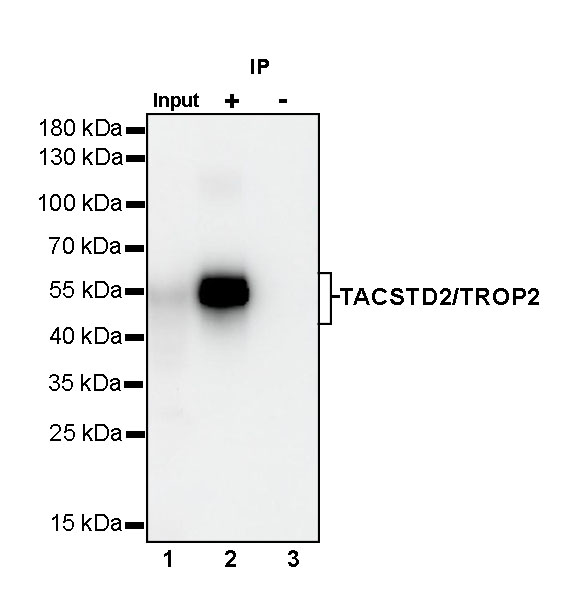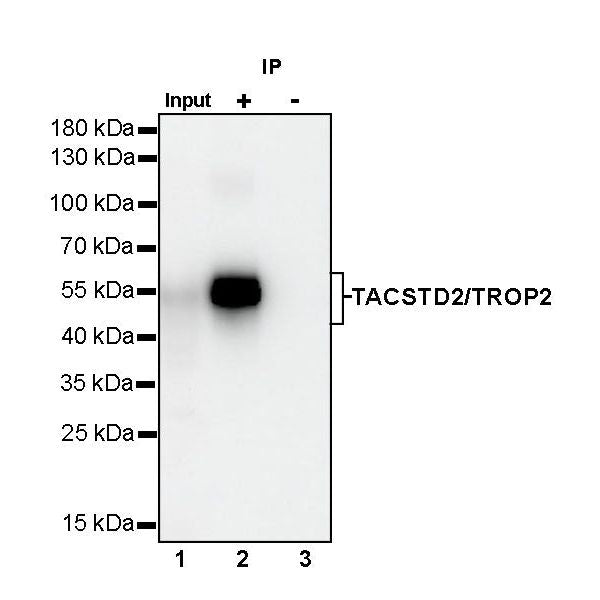WB result of TACSTD2/TROP2 Rabbit mAb
Primary antibody: TACSTD2/TROP2 Rabbit mAb at 1/1000 dilution
Lane 1: PC-3 whole cell lysate 20 µg
Lane 2: MCF7 whole cell lysate 20 µg
Secondary antibody: Goat Anti-Rabbit IgG, (H+L), HRP conjugated at 1/10000 dilution
Predicted MW: 36 kDa
Observed MW: 40~65 kDa
(This blot was developed with high sensitivity substrate)
Product Details
Product Details
Product Specification
| Host | Rabbit |
| Antigen | TACSTD2/TROP2 |
| Synonyms | Tumor-associated calcium signal transducer 2, Cell surface glycoprotein Trop-2, Membrane component chromosome 1 surface marker 1, Pancreatic carcinoma marker protein GA733-1, GA733-1, M1S1 |
| Location | Membrane |
| Accession | P09758 |
| Clone Number | S-R238 |
| Antibody Type | Recombinant mAb |
| Application | WB, IHC-P, IP |
| Reactivity | Hu |
| Purification | Protein A |
| Concentration | 0.5 mg/ml |
| Conjugation | Unconjugated |
| Physical Appearance | Liquid |
| Storage Buffer | PBS, 40% Glycerol, 0.05%BSA, 0.03% Proclin 300 |
| Stability & Storage | 12 months from date of receipt / reconstitution, -20 °C as supplied |
Dilution
| application | dilution | species |
| WB | 1:1000 | null |
| IHC | 1:500 | null |
| IP | 1:35 | null |
Background
Tumor-associated calcium signal transducer 2, also known as Trop-2 and as epithelial glycoprotein-1 antigen (EGP-1), is a protein that in humans is encoded by the TACSTD2 gene. Trop-2 expression was originally described in trophoblasts (placenta) and fetal tissues (e.g., lung). Later, its expression was also described in the normal stratified squamous epithelium of the skin, uterine cervix, esophagus, and tonsillar crypts. Trop-2 plays a role in tumor progression by actively interacting with several key molecular signaling pathways traditionally associated with cancer development and progression. Aberrant overexpression of Trop-2 has been described in several solid cancers, such as colorectal, renal, lung, and breast cancers. Trop-2 expression has also been described in some rare and aggressive malignancies, e.g., salivary duct, anaplastic thyroid, uterine/ovarian, and neuroendocrine prostate cancers.
Picture
Picture
Western Blot
IP

TACSTD2/TROP2 Rabbit mAb at 1/35 dilution (1 µg) immunoprecipitating TACSTD2/TROP2 in 0.28 mg MCF-7 whole cell lysate.
Western blot was performed on the immunoprecipitate using TACSTD2/TROP2 Rabbit mAb at 1/1000 dilution.
Secondary antibody (HRP) for IP was used at 1/400 dilution.
Lane 1:MCF-7 whole cell lysate 20 µg (Input)
Lane 2: TACSTD2/TROP2 Rabbit mAb IP in MCF-7 whole cell lysate
Lane 3: Rabbit monoclonal IgG IP in MCF-7 whole cell lysate
Predicted MW: 36 kDa
Observed MW: 40~65 kDa
(This blot was developed with high sensitivity substrate)
Immunohistochemistry
IHC shows positive staining in paraffin-embedded human esophagus. Anti-TACSTD2/TROP2 antibody was used at 1/500 dilution, followed by a HRP Polymer for Mouse & Rabbit IgG (ready to use). Counterstained with hematoxylin. Heat mediated antigen retrieval with Tris/EDTA buffer pH9.0 was performed before commencing with IHC staining protocol.
IHC shows positive staining in paraffin-embedded human kidney. Anti-TACSTD2/TROP2 antibody was used at 1/500 dilution, followed by a HRP Polymer for Mouse & Rabbit IgG (ready to use). Counterstained with hematoxylin. Heat mediated antigen retrieval with Tris/EDTA buffer pH9.0 was performed before commencing with IHC staining protocol.
IHC shows positive staining in paraffin-embedded human tonsil. Anti-TACSTD2/TROP2 antibody was used at 1/500 dilution, followed by a HRP Polymer for Mouse & Rabbit IgG (ready to use). Counterstained with hematoxylin. Heat mediated antigen retrieval with Tris/EDTA buffer pH9.0 was performed before commencing with IHC staining protocol.
IHC shows positive staining in paraffin-embedded human prostate. Anti-TACSTD2/TROP2 antibody was used at 1/500 dilution, followed by a HRP Polymer for Mouse & Rabbit IgG (ready to use). Counterstained with hematoxylin. Heat mediated antigen retrieval with Tris/EDTA buffer pH9.0 was performed before commencing with IHC staining protocol.
Negative control: IHC shows negative staining in paraffin-embedded human cerebral cortex. Anti-TACSTD2/TROP2 antibody was used at 1/500 dilution, followed by a HRP Polymer for Mouse & Rabbit IgG (ready to use). Counterstained with hematoxylin. Heat mediated antigen retrieval with Tris/EDTA buffer pH9.0 was performed before commencing with IHC staining protocol.
IHC shows positive staining in paraffin-embedded human breast cancer. Anti-TACSTD2/TROP2 antibody was used at 1/500 dilution, followed by a HRP Polymer for Mouse & Rabbit IgG (ready to use). Counterstained with hematoxylin. Heat mediated antigen retrieval with Tris/EDTA buffer pH9.0 was performed before commencing with IHC staining protocol.
IHC shows positive staining in paraffin-embedded human cervical squamous cell carcinoma. Anti-TACSTD2/TROP2 antibody was used at 1/500 dilution, followed by a HRP Polymer for Mouse & Rabbit IgG (ready to use). Counterstained with hematoxylin. Heat mediated antigen retrieval with Tris/EDTA buffer pH9.0 was performed before commencing with IHC staining protocol.
IHC shows positive staining in paraffin-embedded human lung adenocarcinoma. Anti-TACSTD2/TROP2 antibody was used at 1/500 dilution, followed by a HRP Polymer for Mouse & Rabbit IgG (ready to use). Counterstained with hematoxylin. Heat mediated antigen retrieval with Tris/EDTA buffer pH9.0 was performed before commencing with IHC staining protocol.
IHC shows positive staining in paraffin-embedded human prostatic carcinoma. Anti-TACSTD2/TROP2 antibody was used at 1/500 dilution, followed by a HRP Polymer for Mouse & Rabbit IgG (ready to use). Counterstained with hematoxylin. Heat mediated antigen retrieval with Tris/EDTA buffer pH9.0 was performed before commencing with IHC staining protocol.


